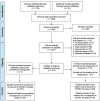Anosmia and dysgeusia in SARS-CoV-2 infection: incidence and effects on COVID-19 severity and mortality, and the possible pathobiology mechanisms - a systematic review and meta-analysis
- PMID: 33824716
- PMCID: PMC7993408
- DOI: 10.12688/f1000research.28393.1
Anosmia and dysgeusia in SARS-CoV-2 infection: incidence and effects on COVID-19 severity and mortality, and the possible pathobiology mechanisms - a systematic review and meta-analysis
Abstract
Background: The present study aimed to determine the global prevalence of anosmia and dysgeusia in coronavirus disease 2019 (COVID-19) patients and to assess their association with severity and mortality of COVID-19. Moreover, this study aimed to discuss the possible pathobiological mechanisms of anosmia and dysgeusia in COVID-19. Methods: Available articles from PubMed, Scopus, Web of Science, and preprint databases (MedRxiv, BioRxiv, and Researchsquare) were searched on November 10th, 2020. Data on the characteristics of the study (anosmia, dysgeusia, and COVID-19) were extracted following the Preferred Reporting Items for Systematic Reviews and Meta-Analyses (PRISMA) guideline. Newcastle-Ottawa scale was used to assess research quality. Moreover, the pooled prevalence of anosmia and dysgeusia were calculated, and the association between anosmia and dysgeusia in presence of severe acute respiratory syndrome coronavirus 2 (SARS-CoV-2) was assessed using the Z test. Results: Out of 32,142 COVID-19 patients from 107 studies, anosmia was reported in 12,038 patients with a prevalence of 38.2% (95% CI: 36.5%, 47.2%); whereas, dysgeusia was reported in 11,337 patients out of 30,901 COVID-19 patients from 101 studies, with prevalence of 36.6% (95% CI: 35.2%, 45.2%), worldwide. Furthermore, the prevalence of anosmia was 10.2-fold higher (OR: 10.21; 95% CI: 6.53, 15.96, p < 0.001) and that of dysgeusia was 8.6-fold higher (OR: 8.61; 95% CI: 5.26, 14.11, p < 0.001) in COVID-19 patients compared to those with other respiratory infections or COVID-19 like illness. To date, no study has assessed the association of anosmia and dysgeusia with severity and mortality of COVID-19. Conclusion: Anosmia and dysgeusia are prevalent in COVID-19 patients compared to those with the other non-COVID-19 respiratory infections. Several possible mechanisms have been hypothesized; however, future studies are warranted to elucidate the definitive mechanisms of anosmia and dysgeusia in COVID-19. Protocol registration: PROSPERO CRD42020223204.
Keywords: COVID-19; SARS-CoV-2; anosmia; dysgeusia; predictor.
Copyright: © 2021 Mutiawati E et al.
Conflict of interest statement
No competing interests were disclosed.
Figures



Similar articles
-
COVID-19 with and without anosmia or dysgeusia: A case-control study.J Med Virol. 2021 Apr;93(4):2499-2504. doi: 10.1002/jmv.26784. Epub 2021 Jan 22. J Med Virol. 2021. PMID: 33417259
-
Global prevalence and pathogenesis of headache in COVID-19: A systematic review and meta-analysis.F1000Res. 2020 Nov 12;9:1316. doi: 10.12688/f1000research.27334.2. eCollection 2020. F1000Res. 2020. PMID: 33953911 Free PMC article.
-
Pathogenesis and progression of anosmia and dysgeusia during the COVID-19 pandemic.Eur Arch Otorhinolaryngol. 2023 Feb;280(2):505-509. doi: 10.1007/s00405-022-07689-w. Epub 2022 Oct 9. Eur Arch Otorhinolaryngol. 2023. PMID: 36209486 Free PMC article. Review.
-
Long-Term Neurological Sequelae Among Severe COVID-19 Patients: A Systematic Review and Meta-Analysis.Cureus. 2022 Sep 28;14(9):e29694. doi: 10.7759/cureus.29694. eCollection 2022 Sep. Cureus. 2022. PMID: 36321004 Free PMC article. Review.
-
Can symptoms of anosmia and dysgeusia be diagnostic for COVID-19?Brain Behav. 2020 Nov;10(11):e01839. doi: 10.1002/brb3.1839. Epub 2020 Sep 16. Brain Behav. 2020. PMID: 32935915 Free PMC article. Review.
Cited by
-
Morphological and Immunopathological Aspects of Lingual Tissues in COVID-19.Cells. 2022 Apr 6;11(7):1248. doi: 10.3390/cells11071248. Cells. 2022. PMID: 35406811 Free PMC article.
-
Prevalence of Olfactory Dysfuntion in SARS-COV-2 Positive Patients.Indian J Otolaryngol Head Neck Surg. 2022 Oct;74(Suppl 2):3204-3212. doi: 10.1007/s12070-021-02954-6. Epub 2021 Oct 28. Indian J Otolaryngol Head Neck Surg. 2022. PMID: 34729366 Free PMC article.
-
Prevalence of Chemosensitive Neurological Disorders of Smell and Taste and Association with Blood Groups in SARS-CoV-2 Patients: Cross-Sectional Study.Viruses. 2023 May 30;15(6):1277. doi: 10.3390/v15061277. Viruses. 2023. PMID: 37376577 Free PMC article.
-
An Epigenetic Locus Associated with Loss of Smell in COVID-19.Diagnostics (Basel). 2024 Dec 15;14(24):2823. doi: 10.3390/diagnostics14242823. Diagnostics (Basel). 2024. PMID: 39767184 Free PMC article.
-
Chemosensory Ability and Sensitivity in Health and Disease: Epigenetic Regulation and COVID-19.Int J Mol Sci. 2023 Feb 20;24(4):4179. doi: 10.3390/ijms24044179. Int J Mol Sci. 2023. PMID: 36835589 Free PMC article. Review.
References
-
- Worldometers: COVID-19 coronavirus pandemic. Reference Source[cited 2020 November 14]
Publication types
MeSH terms
Associated data
LinkOut - more resources
Full Text Sources
Other Literature Sources
Medical
Miscellaneous

